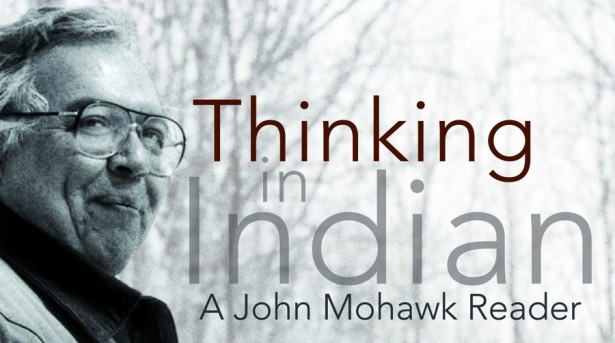
It is almost cliché, the term of measurement called Seven Generations (the idea that the decisions we make today must be weighed by its effect on the seventh generation to come). Thinking in Indian, A John Mohawk Reader teaches what the phrase actually means. Mohawk, who died in 2006, urged us to ask, “What is the Life Supportive Index (LSI) of an idea, a concept or a technology?” Or, what is the true cost of an action in terms of the LSI? Calculating an LSI requires thinking in centuries; hence the generations. What is the cost of burning coal for power in terms of resource depletion, environmental clean up and future healthcare problems?
A Seneca Nation elder, thinker and activist, John Mohawk (Sotsisowah) challenged readers to reset and then reboot their value systems—to consider the obvious that we are trained in school to ignore. Expediency is replaced by patience and common sense, an approach not promoted very much in this technological era.
Mohawk, an Iroquois traditionalist was a comical, analytical and complex fellow. The book’s editor, Dr. José Barreiro, treats his manuscripts with a skilled eye, steady hand and a perception that has been honed over decades of interactions with Mohawk and many other great indigenous thinkers. According to Mohawk, Jesus Christ’s message was manipulated to make the technology of conquest a natural, even an honorable, pursuit:
“People had long ago abandoned ‘faith’ in God as a way of life. Christ’s admonition to people to trust in God (read: nature), when he said that God provides for the birds and will provide for the faithful as well, was entirely disregarded by the Christian world. It was considered, in a manner of speaking, advice for the birds. In fact, the West has developed more food-storage technology than any other people to guard against the possibility that God might not provide for the future. The true religion in the West was better expressed by the sentiments that “God helps those who help themselves,” and the more ways people invent to help themselves, the better.
Mohawk’s love for humanity was strong, he did not just target a singular audience, us indigenous; he was warning others: People from Europe whose ancestors were as tribal as we; Italians, Scots, Irish and yes, Palestinian, Israeli and all of humanity.
In the first major treatise written by Mohawk and presented by the indigenous delegation to the Nongovernmental Organizations of the United Nations at Geneva, Switzerland in 1977, he wrote: “A strategy for survival must include a liberation theology—call it a philosophy or cosmology if you will, but we believe it to be a theology—or humankind will simply continue…to seek more efficient ways to exploit that which they have come to respect. If these processes continue unabated and unchanged at the foundation of the colonizers’s ideology, our species will never be liberated from the undeniable reality that we live on a planet of limited resources, and sooner or later we will exploit our environment beyond its ability to renew itself.”
Prophet? Scholar? Advocate? Peacemaker? Negotiator? Radical? Naturalist? Mohawk was a man among men. He understood much because he was patient and managed to have the fortitude to look beyond the person and listen to what they had to say.
Thinking in Indian is a sort of indigenous social-political-medical journal. It’s divided into five sections: Earth Spirit—the origins of indigenous values; Indigenous Economics—Indians have always had an economy; Nation and Governance—indigenous people were not anarchists; Native Rights—Indians are people too; and lastly Political Philosophy—how we see ourselves and how we see the world. The collection is partly what our Native elders instructed Mohawk to share and partly what the Native youth need to be armed with to interpret the world. His analyses are meant to empower our society, help save our lives, save our families and reinvigorate an acceptable value system (localization) that can reverse the destruction of the earth before she destroys us—the flea on the dog’s back.
Mohawk was a Haudenosaunee culture-bearer. He carried the bones of our ancestors into the political discussions of today. He said, “I once heard that culture is what one does without thinking about it.”
He also said: “Ever since the West embarked on this path, necessity has truly been the mother of invention. What has changed has been what was necessary.”
And: “In the 20th century, we are viewing the continuation of the drama of Western man in his quest to stay one step ahead of disaster.” Amazing. And humorous.
If you did not get it the first time, if you did not hear the same ancient Native prophecies he heard, you can hear them now. If you want to compare notes with a man who was a thousand years old in his thinking while also a contemporary of scholars around the world, this is the book for you. It does not get more Indian than this.
Edited by Dr. José Barreiro, senior scholar, National Museum of the American Indian.
© 1998 - 2011 Indian Country Today. All Rights Reserved To subscribe or visit go to: http://www.indiancountry.com